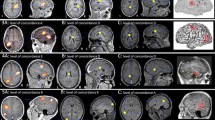Summary
In rolandic epilepsy, consideration of the stereotyped ictal symptomatology suggests that the epileptic zone is likely to be in the same cortical structure in different patients. Routine EEG tracings of the interictal spike activity suggests a deep Sylvian fissure location. On the basis of the predominantly tangential potential field at the peak spike negativity seen in this group of patients, the inferior bank of the Sylvian fissure appears to be a good candidate. Without invasive studies, little refinement to this rather imprecise localization can be made as there is neither neurologic deficit nor lesion to provide a marker on radiological imaging. However, the application of source modelling technique using a simple single-dipole spherical head model has resulted in improved understanding of the generator behaviour, and facilitated the generation of new ways of analyzing spikes (e.g., stability index). Review of newer quantitative approaches including matrix and singular value decomposition of the dataset, spatial-temporal constrained source estimates etc. suggest other fruitful approaches. At least in some patients with partial epilepsy, the source characteristics of interictal scalp spikes appear to contain information of the ictal generator. Under certain circumstances, such derived information which is not otherwise available from routine electrophysiology may influence clinical management and prognosis. This is an additional bonus to the primary objectives of quantification and data reduction.
Similar content being viewed by others
References
Achim, A., Richer, F., Saint-Hilaire, J.M. Methods for separating temporally overlapping sources of neuroelectric data. Brain Topography 1988, 1(1): 22–28.
Bencivenga, R. A statistical analysis of EEG spikes in benign rolandic epilepsy of childhood. (1987) Thesis, Dept. of Statistics, University of British Columbia, Vancouver, B.C., Canada.
Ebersole, J.S. EEG dipole modeling in complex partial epilepsy. Brain Topography, 1991, 4(2): 113–124.
Ebersole, J.S. and Wade, P.B. Intracranial EEG validation os spike topography and dipole modelling in the presurgical localization of epileptic foci. Epilepsia 1989a 30: 696.
Ebersole, J.S. and Wade, P.B. Temporal spikes are not all the same - a topographic EEG analysis in surgical candidates. Neurology 1989b 39: (supp 1) 299.
Ebersole, J.S. and Wade, P.B. Spike voltage topography identifies two types of fronto-temporal epileptic foci. Neurology 1991, 41: 1425–1433.
Gevins, A., Brickett, P., Costales, B., Le, J. and Reutter, B. Beyond topographic mapping: towards functional-anatomical imaging with 124-channel EEGs and 3-D MRIs. Brain Topography 1990, 3(1): 53–64.
Gregory, D.L. and Wong, P.K.H. Topographical analysis of the centrotemporal discharges in benign rolandic epilepsy of childhood. Epilepsia, 1984, 25: 705–711.
Gregory, D.L. and Wong, P.K.H. Centrotemporal spike focus: the clinical significance of a dipole field. Electroenceph Clin Neurophysiol, 1985, 61: S183.
Gregory, D.L. and Wong, P.K.H. The clinical relevance of a dipole field in rolandic spikes. Epilepsia (in press).
Harner, R. and Riggio, S. Application of singular value decomposition to topographic analysis of flash-evoked potentials. Brain Topography 1989, 2(1/2): 91–98.
Lombroso, C.T. Sylvian seizures and midtemporal spike foci in children. Arch. Neurol. 1967, 17: 52–59.
Luders, H., Daube, J.R., Taylor, W.F. and Klass, D.W. (1976) A computer system for statistical analysis of EEG transients. In: P. Kellaway and I. Petersen (Eds.), Quantitative Analytic Studies in Epilepsy. Raven Press, New York, pp. 403–429.
Rodin, E. and Ancheta, O. Cerebral electric fields during petit mal absences. Electroenceph Clin Neurophysiol 1987, 66: 456–466.
Rodin, E. and Cornellier, D. Source derivation recordings of generalized spike-wave complexes. Electroenceph Clin Neurophysiol 1989, 73: 20–29.
Scherg, M. and von Cramon, D. Evoked dipole source potentials of the human auditory cortex. Electroenceph Clin Neurophysiol 1986, 65: 344–360.
Sutherling, W.W., Crandall, P.H., Cahan, L.D. and Barth, D.S. The magnetic field of epileptic spikes agrees with intracranial localizations in complex partial epilepsy. Neurology 1988, 38: 778–786.
Weinberg, H., Wong, P.K.H., Crisp, D., Johnson, B. and Cheyne, D. Use of multiple dipole analysis for the classification of benign rolandic epilepsy. Brain Topography 1990, 3(1): 183–190.
Wong, P.K.H. Stability of source estimates in rolandic spikes. Brain Topography 1989, 2(1/2): 31–36.
Wong, P.K.H. Introduction to Brain Topography. Plenum Press, New York and London, 1991a.
Wong, P.K.H., Bencivenga, R. and Gregory, D. Statistical classification of spikes in benign rolandic epilepsy. Brain Topography 1989, 1(2): 123–129.
Wong, P.K.H. and Weinberg, H. (1986). Source estimation of scalp EEG focus. In G. Pfurtscheller and F. Lopes da Silva (eds): Functional Brain Imaging. Toronto: Hans Huber Publishers, pp. 89–95.
Author information
Authors and Affiliations
Rights and permissions
About this article
Cite this article
Wong, P.K.H. Source modelling of the rolandic focus. Brain Topogr 4, 105–112 (1991). https://doi.org/10.1007/BF01132767
Accepted:
Issue Date:
DOI: https://doi.org/10.1007/BF01132767




